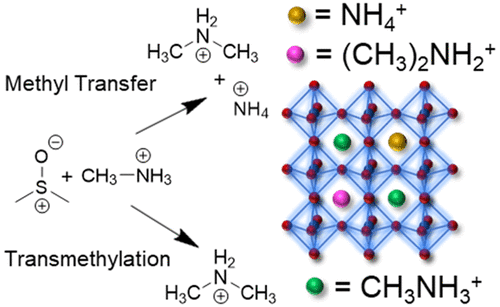当前位置:
X-MOL 学术
›
Chem. Mater.
›
论文详情
Our official English website, www.x-mol.net, welcomes your
feedback! (Note: you will need to create a separate account there.)
Acid-Catalyzed Reactions Activate DMSO as a Reagent in Perovskite Precursor Inks
Chemistry of Materials ( IF 7.2 ) Pub Date : 2019-02-25 00:00:00 , DOI: 10.1021/acs.chemmater.9b00019
J. Clay Hamill , Jeni C. Sorli , István Pelczer , Jeffrey Schwartz , Yueh-Lin Loo
Chemistry of Materials ( IF 7.2 ) Pub Date : 2019-02-25 00:00:00 , DOI: 10.1021/acs.chemmater.9b00019
J. Clay Hamill , Jeni C. Sorli , István Pelczer , Jeffrey Schwartz , Yueh-Lin Loo

|
Proton transfer from methylammonium (CH3NH3+) to dimethylsulfoxide (DMSO), a common Lewis-base solvent, initiates the production of ammonium (NH4+) and dimethylammonium ([CH3]2NH2+). We propose two parallel reaction pathways initiated by this proton transfer. Using DMSO-d6 to elucidate reaction schemes, we demonstrate that protonation is followed either by methyl group transfer between the resulting CH3NH2 and residual CH3NH3+, or by transmethylation to CH3NH2 from DMSOH+. The former reaction yields NH4+ and (CH3)2NH2+ and is the dominant pathway at processing relevant temperatures; the latter yields (CH3)2NH2+ in addition to methylsulfonic acid and dimethylsulfide. In the preparation of hybrid organic–inorganic perovskite (HOIP) thin films for photovoltaic applications, the substitution of CH3NH3+ with NH4+ and (CH3)2NH2+ in the HOIP crystal results in deviations from the tetragonal structure expected of phase-pure CH3NH3PbI3, with a deleterious effect on the absorptivity of the resulting films. These results emphasize the importance of elucidating the under-appreciated precursor/solvent reactivity, the products of which, when incorporated into the solid state, can have profound effects on HOIP composition and structure, with a commensurate impact on macroscopic properties and device performance.
中文翻译:

酸催化反应将DMSO活化为钙钛矿前体油墨中的试剂
质子从甲基铵(CH 3 NH 3 +)转移到二甲基亚砜(DMSO)(一种常见的路易斯碱溶剂),引发了铵(NH 4 +)和二甲基铵([CH 3 ] 2 NH 2 +)的生产。我们提出了由该质子转移引发的两个平行反应途径。使用DMSO- d 6阐明反应方案,我们证明质子化之后是在所得CH 3 NH 2和残留的CH 3 NH 3 +之间进行甲基转移,或通过甲基化转变为CH 3 NH2来自DMSOH +。前者反应生成NH 4 +和(CH 3)2 NH 2 +,并且是处理相关温度下的主要途径。后者除了产生甲基磺酸和二甲基硫醚外,还产生(CH 3)2 NH 2 +。在杂化有机-无机钙钛矿(HOIP)薄膜用于光伏应用,CH的取代的制备3 NH 3 +与NH 4 +和(CH 3)2 NH 2 +HOIP晶体中的α会导致偏离纯相CH 3 NH 3 PbI 3预期的四方结构,从而对所得薄膜的吸收率产生有害影响。这些结果强调了阐明未被充分认识的前体/溶剂反应性的重要性,当将其产物掺入固态时,其产物可对HOIP组成和结构产生深远影响,并对宏观性能和器件性能产生相应影响。
更新日期:2019-02-25
中文翻译:

酸催化反应将DMSO活化为钙钛矿前体油墨中的试剂
质子从甲基铵(CH 3 NH 3 +)转移到二甲基亚砜(DMSO)(一种常见的路易斯碱溶剂),引发了铵(NH 4 +)和二甲基铵([CH 3 ] 2 NH 2 +)的生产。我们提出了由该质子转移引发的两个平行反应途径。使用DMSO- d 6阐明反应方案,我们证明质子化之后是在所得CH 3 NH 2和残留的CH 3 NH 3 +之间进行甲基转移,或通过甲基化转变为CH 3 NH2来自DMSOH +。前者反应生成NH 4 +和(CH 3)2 NH 2 +,并且是处理相关温度下的主要途径。后者除了产生甲基磺酸和二甲基硫醚外,还产生(CH 3)2 NH 2 +。在杂化有机-无机钙钛矿(HOIP)薄膜用于光伏应用,CH的取代的制备3 NH 3 +与NH 4 +和(CH 3)2 NH 2 +HOIP晶体中的α会导致偏离纯相CH 3 NH 3 PbI 3预期的四方结构,从而对所得薄膜的吸收率产生有害影响。这些结果强调了阐明未被充分认识的前体/溶剂反应性的重要性,当将其产物掺入固态时,其产物可对HOIP组成和结构产生深远影响,并对宏观性能和器件性能产生相应影响。

































 京公网安备 11010802027423号
京公网安备 11010802027423号